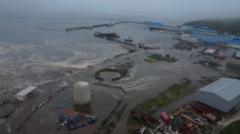The Pacific region is on high alert following a colossal 8.8 magnitude earthquake that struck off the coast of Russia's Kamchatka Peninsula at 11:25 AM local time on Wednesday, causing widespread tsunami warnings. Observed as one of the strongest quakes recorded, this seismic event has led to evacuations across Japan, parts of the US west coast, and multiple countries across the Pacific.
Videos from Severo-Kurilsk, located in Russia, depict chaotic scenes as large waves inundated buildings, flooding a port and fish processing facility, while local vessels were swept away. Power supply disruptions occurred in the Sakhalin region, causing additional concerns for those affected.
Japan has seen a significant response, with approximately 1.9 million people ordered to evacuate. Authorities have advised residents to seek higher ground, with reports of individuals sheltering atop structures in Hokkaido. Meanwhile, in Hawaii, officials have warned of potential 10-foot waves, though the state's governor reported no damaging waves have yet been observed, advising that an "all clear" will follow in two to three hours.
Experts continue to analyze the situation, with predictions about damage remaining uncertain. Chris Goldfinger, a marine geology professor at Oregon State University, remarked that ongoing research is crucial for refining forecasts and understanding the unique responses of various coastal areas. He highlighted that regions directly in line with the energy wave from Kamchatka are expected to face the greatest impacts.
Timing for tsunami waves reaching different locations has been established, with observations suggesting waves could reach British Columbia and California by 12:20 AM local time. Nome, Alaska, is anticipated to see waves by 3:20 AM. Experts likened the tsunami's speed to that of an airplane, providing a relatable frame of reference for expected travel times.
The US Geological Survey reported that the quake occurred relatively shallow at a depth of 19.3 km and approximately 119 km east-southeast of Petropavlovsk-Kamchatsky, with initial magnitude assessments adjusted upwards. This earthquake is among the top six most powerful in history, likened to the 2010 Biobío, Chile earthquake as well as a 1906 quake in Ecuador, while the infamous 2004 Indian Ocean earthquake remains one of the most devastating.
As more information unfolds, authorities are working tirelessly to monitor the situation and ensure public safety across the affected regions.
Videos from Severo-Kurilsk, located in Russia, depict chaotic scenes as large waves inundated buildings, flooding a port and fish processing facility, while local vessels were swept away. Power supply disruptions occurred in the Sakhalin region, causing additional concerns for those affected.
Japan has seen a significant response, with approximately 1.9 million people ordered to evacuate. Authorities have advised residents to seek higher ground, with reports of individuals sheltering atop structures in Hokkaido. Meanwhile, in Hawaii, officials have warned of potential 10-foot waves, though the state's governor reported no damaging waves have yet been observed, advising that an "all clear" will follow in two to three hours.
Experts continue to analyze the situation, with predictions about damage remaining uncertain. Chris Goldfinger, a marine geology professor at Oregon State University, remarked that ongoing research is crucial for refining forecasts and understanding the unique responses of various coastal areas. He highlighted that regions directly in line with the energy wave from Kamchatka are expected to face the greatest impacts.
Timing for tsunami waves reaching different locations has been established, with observations suggesting waves could reach British Columbia and California by 12:20 AM local time. Nome, Alaska, is anticipated to see waves by 3:20 AM. Experts likened the tsunami's speed to that of an airplane, providing a relatable frame of reference for expected travel times.
The US Geological Survey reported that the quake occurred relatively shallow at a depth of 19.3 km and approximately 119 km east-southeast of Petropavlovsk-Kamchatsky, with initial magnitude assessments adjusted upwards. This earthquake is among the top six most powerful in history, likened to the 2010 Biobío, Chile earthquake as well as a 1906 quake in Ecuador, while the infamous 2004 Indian Ocean earthquake remains one of the most devastating.
As more information unfolds, authorities are working tirelessly to monitor the situation and ensure public safety across the affected regions.















